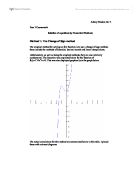θ = x/L.
Since the angle would be so minute, sinθ would also be approximately θ. Therefore:
λ = (dsinθ)/m
λ = (dx)/(mL).
Hypothesis:
If one shines a He-Ne laser through different diffraction gratings and observes the interference pattern made on a surface, then one can calculate the wavelength of a He-Ne laser using the equation λ = (dx)/(mL).
Variables:
Independent:
-
Distance from diffraction grating to screen L
-
Distance between lines in each diffraction grating d
-
Order of the fringe considered m
- Distance between laser and diffraction grating
Dependent:
-
Angle at which laser is diffracted at the first order fringe θ
-
Distance between the central bright beam and the first fringe x
-
Calculated wavelength of the He-Ne laser λ
Materials:
- 1 diffraction grating of 600 lines/mm
- 1 diffraction grating of 300 lines/mm
- 1 diffraction grating of 100 lines/mm
- 1 grating holder
- 1 He-Ne laser
- 1 meter-stick
Method:
- Place the He-Ne laser on a level surface, facing a screen.
- Obtain the 600 lines/mm diffraction grating, and place it 30cm in front of the laser (between the laser and the screen).
- Make sure that the diffraction grating is at least 1.5m from the screen, and that when the laser is switched on, the beam passes through the center of the grating.
- Switch on the laser.
- Measure the distance between the central bright beam and the first order fringe to the right of it. Record.
- Repeat step 5 for the next two orders of fringes to the right of the central bright beam.
- Repeat steps 2-6 for the 300 lines/mm diffraction grating and the 100 lines/mm diffraction grating.
- Measure the distance from the diffraction grating to the screen and record.
- Using these values, calculate the wavelength of the laser for each fringe order considered for each diffraction grating used.
Data Collection:
Quantitative Data:
Distance from diffraction grating to screen300 lines/mm (± 0.002m) = 2.790m
Distance from diffraction grating to screen100 lines/mm (± 0.002m) = 4.410m
Distance from diffraction grating to screen600 lines/mm (± 0.002m) = 4.410m
Table 1: Distances between central bright beam and first, second, and third order fringes for diffraction gratings
Note: the distance between the central beam and second/third fringes for the 600 lines/mm diffraction grating could not be found because they were too far away to practically calculate.
Qualitative Data:
As the diffraction grating spacing increases, the distance between the central beam and the first/second/third order fringes seems to decrease. Also, the distances between the central beam and the first order fringe to the left and the first order fringe to the right seem to be equal. This is the same for the second and third order fringes. However, there seems to be slightly more space between the first order fringe and the second order fringe than between the central beam and the first order fringe. Likewise, there seems to be more slightly more space between the third order fringe and the second order fringe than between the second order fringe and the first order fringe.
Data Processing and Presentation:
600 lines/mm Diffraction Grating
Calculation of λ for First Order Fringe
As mentioned before, λ can be calculated by using the equation:
λ = (dx)/(mL).
One can find d by dividing 1 by the number of lines/m:
d = 1/lines per meter
d = 1/(6.00 x 105)
d ≈ 1.67 x 10-6m
So:
λ = (dx)/(mL)
λ = ((1.67 x 10-6)(2.08))/((1.00)(4.41))
λ ≈ 7.88 x 10-7m = 788nm ± 1nm
300 lines/mm Diffraction Grating
Calculation of λ for First Order Fringe
One can find d by dividing 1 by the number of lines/m:
d = 1/lines per meter
d = 1/(3.00 x 105)
d ≈ 3.33 x 10-6m
So:
λ = (dx)/(mL)
λ = ((3.33 x 10-6)(0.573))/((1.00)(2.79))
λ ≈ 6.84 x 10-7m = 684nm ± 1nm
Calculation of λ for Second Order Fringe
λ = (dx)/(mL)
λ = ((3.33 x 10-6)(1.228))/((2.00)(2.79))
λ ≈ 7.33 x 10-7m = 733nm ± 1nm
Calculation of λ for Third Order Fringe
λ = (dx)/(mL)
λ = ((3.33 x 10-6)(2.122))/((3.00)(2.79))
λ ≈ 8.44 x 10-7m = 844nm ± 1nm
100 lines/mm Diffraction Grating
Calculation of λ for First Order Fringe
One can find d by dividing 1 by the number of lines/m:
d = 1/lines per meter
d = 1/(1.00 x 105)
d ≈ 1.00 x 10-5m
So:
λ = (dx)/(mL)
λ = ((1.00 x 10-5)(0.303))/((1.00)(4.41))
λ ≈ 6.87 x 10-7m = 686nm ± 1nm
Calculation of λ for Second Order Fringe
λ = (dx)/(mL)
λ = ((1.00 x 10-5)(0.605))/((2.00)(4.41))
λ ≈ 6.86 x 10-7m = 686nm ± 1nm
Calculation of λ for Third Order Fringe
λ = (dx)/(mL)
λ = ((1.000 x 10-5)(0.915))/((3.00)(4.41))
λ ≈ 6.92 x 10-7m = 692nm ± 1nm
Conclusion and Evaluation:
Errors in Apparatus
In this experiment, the only equipment used in which one must consider error is the meter-stick, which has an error of about ± 0.002m. In each calculation of the wavelength, the measurements that carry this error are used twice. The following is the calculation of the relative uncertainty due to the use of the meter-stick in each calculation:
600 lines/mm
1st Fringe
x = 2.080 ± 0.002m, uncertainty = 0.002/2.080 x 100 ≈ 0.096%
L = 4.410 ± 0.002m, uncertainty = 0.002/4.410 x 100 ≈ 0.045%
0.096% + 0.045% = 0.141%
0.141% of 7.88 x 10-7 ≈ 1.11 x 10-9
7.88 x 10-7 ± 1.11 x 10-9m
300 lines/mm
1st Fringe
x = 0.573 ± 0.002m, uncertainty = 0.002/0.573 x 100 ≈ 0.349%
L = 2.790 ± 0.002m, uncertainty = 0.002/2.790 x 100 ≈ 0.072%
0.349% + 0.072% = 0.421%
0.421% of 6.84 x 10-7 ≈ 2.88 x 10-9
6.84 x 10-7 ± 2.88 x 10-9m
2nd Fringe
x = 1.228 ± 0.002m, uncertainty = 0.002/1.228 x 100 ≈ 0.002%
L = 2.790 ± 0.002m, uncertainty = 0.002/2.790 x 100 ≈ 0.072%
0.002% + 0.072% = 0.014%
0.014% of 7.33 x 10-7 ≈ 1.02 x 10-10
7.33 x 10-7 ± 1.02 x 10-10m
3rd Fringe
x = 2.122 ± 0.002m, uncertainty = 0.002/2.122 x 100 ≈ 0.094%
L = 2.790 ± 0.002m, uncertainty = 0.002/2.790 x 100 ≈ 0.072%
0.094% + 0.072% = 0.166%
0.166% of 8.44 x 10-7 ≈ 1.40 x 10-9
8.44 x 10-7 ± 1.40 x 10-9m
100 lines/mm
1st Fringe
x = 0.303 ± 0.002m, uncertainty = 0.002/0.303 x 100 ≈ 0.660%
L = 4.410 ± 0.002m, uncertainty = 0.002/4.410 x 100 ≈ 0.045%
0.660% + 0.045% = 0.705%
0.705% of 6.87 x 10-7 ≈ 4.84 x 10-9
6.87 x 10-7 ± 4.84 x 10-9m
2nd Fringe
x = 0.605 ± 0.002m, uncertainty = 0.002/0.605 x 100 ≈ 0.330%
L = 4.410 ± 0.002m, uncertainty = 0.002/4.410 x 100 ≈ 0.045%
0.330% + 0.045% = 0.375%
0.375% of 6.86 x 10-7 ≈ 2.57 x 10-9
6.86 x 10-7 ± 2.57 x 10-9m
3rd Fringe
x = 0.915 ± 0.002m, uncertainty = 0.002/0.915 x 100 ≈ 0.218%
L = 4.410 ± 0.002m, uncertainty = 0.002/4.410 x 100 ≈ 0.045%
0.218% + 0.045% = 0.263%
0.263% of 6.92 x 10-7 ≈ 1.82 x 10-9
6.92 x 10-7 ± 1.82 x 10-9m
The hypothesis of this experiment is that if one shines a He-Ne laser through different diffraction gratings and observes the interference pattern made on a surface, then one can calculate the wavelength of a He-Ne laser using the equation λ = (dx)/(mL). To calculate whether this hypothesis is reached, it is necessary to calculate the percent error for the calculated wavelengths for each fringe in each diffraction grating:
600 lines/mm
1st Fringe
Percent Error = abs((theoretical value – experimental value)/theoretical value)100%
Percent Error = abs((632.8 – 788)/632.8)100%
Percent Error ≈ 24.5%
300 lines/mm
1st Fringe
Percent Error = abs((theoretical value – experimental value)/theoretical value)100%
Percent Error = abs((632.8 – 684)/632.8)100%
Percent Error ≈ 8.09%
2nd Fringe
Percent Error = abs((theoretical value – experimental value)/theoretical value)100%
Percent Error = abs((632.8 – 733)/632.8)100%
Percent Error ≈ 15.8%
3rd Fringe
Percent Error = abs((theoretical value – experimental value)/theoretical value)100%
Percent Error = abs((632.8 – 844)/632.8)100%
Percent Error ≈ 33.4%
100 lines/mm
1st Fringe
Percent Error = abs((theoretical value – experimental value)/theoretical value)100%
Percent Error = abs((632.8 – 686)/632.8)100%
Percent Error ≈ 8.41%
2nd Fringe
Percent Error = abs((theoretical value – experimental value)/theoretical value)100%
Percent Error = abs((632.8 – 686)/632.8)100%
Percent Error ≈ 8.41%
3rd Fringe
Percent Error = abs((theoretical value – experimental value)/theoretical value)100%
Percent Error = abs((632.8 – 692)/632.8)100%
Percent Error ≈ 9.36%
So, the percent error never goes beyond around 33%. This indicates a successful lab, and it proves the hypothesis true – via diffraction gratings, one has been able to experimentally calculate the wavelength of a He-Ne laser using the equation λ = (dx)/(mL). Upon an examination of the percent errors, it is evident that as the fringe order one considers increases, so does the percent error. An explanation for this could be that the fringes of light that fall on the screen at higher order of fringe may experience other things such as reflection off of other surfaces, and thus may be “diffracted” farther apart than they are supposed to be. Another source for error could very well be that the room is not completely dark during the experiment – there is a slight amount of light coming in through the windows. These light waves could interfere with the light waves of the He-Ne laser (although this would be very minimal), and cause a slight difference in results. A solution to these sources of error could be to conduct the experiment in a room in which no unnecessary objects exist, and a room that can further block more (it is practically impossible to block out all light) light. One other source for error could be that the marks that are made on the screen to indicate where the different order fringes were located are quite large. The size of these marks makes it difficult to accurately measure the values for x, especially with a meter stick. One way to solve this would be to use thinner markers, so that the marks are smaller and thus length measurements can be more accurate. Yet another source of error in the experiment could have been that there is a small amount of dirt on the surface of the diffraction gratings, which would affect the path light travelled through them. The way to eliminate this chance for error would simply be to take care to thoroughly clean the gratings before they are used, so as to wash away any dirt. Of course, errors in the apparatus always exist, but the only way to solve these is to use more precise equipment, or to repeat the experiment to obtain concordant data.
Giancoli, Douglas C. Physics – Principles with Applications. New Jersey: Prentice Hall, 2002.







